An Analysis of New Technologies for Mental Illness Treatments
VerifiedAdded on 2022/09/14
|8
|1986
|39
Essay
AI Summary
This essay examines the application of new technologies in the treatment of mental illness. It explores the use of virtual reality (VR) for treating conditions like PTSD, phobias, and anxiety, highlighting its immersive and interactive nature. The paper also discusses the role of m-health apps, such as ClinTouch, which enable real-time symptom tracking and remote patient monitoring, improving treatment adherence and reducing stigma. Furthermore, the essay delves into the use of therapeutic robots, which leverage artificial intelligence to provide companionship and support, enhancing the therapeutic process and improving patient outcomes. The essay concludes by emphasizing the potential of these technologies to transform mental healthcare and improve the lives of individuals affected by mental illness, while acknowledging the need for further research and development to optimize their effectiveness and address potential side effects.
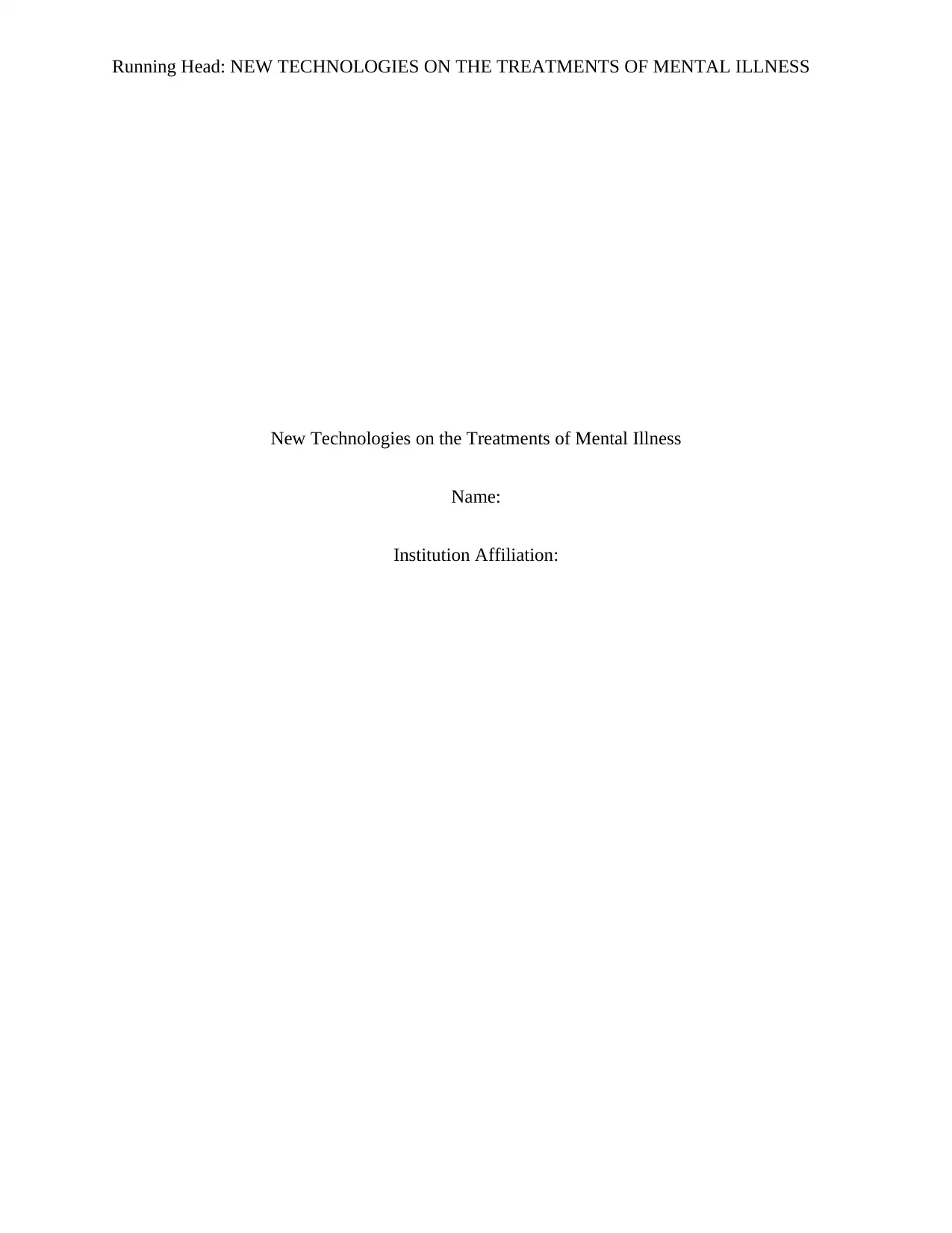
Running Head: NEW TECHNOLOGIES ON THE TREATMENTS OF MENTAL ILLNESS
New Technologies on the Treatments of Mental Illness
Name:
Institution Affiliation:
New Technologies on the Treatments of Mental Illness
Name:
Institution Affiliation:
Paraphrase This Document
Need a fresh take? Get an instant paraphrase of this document with our AI Paraphraser
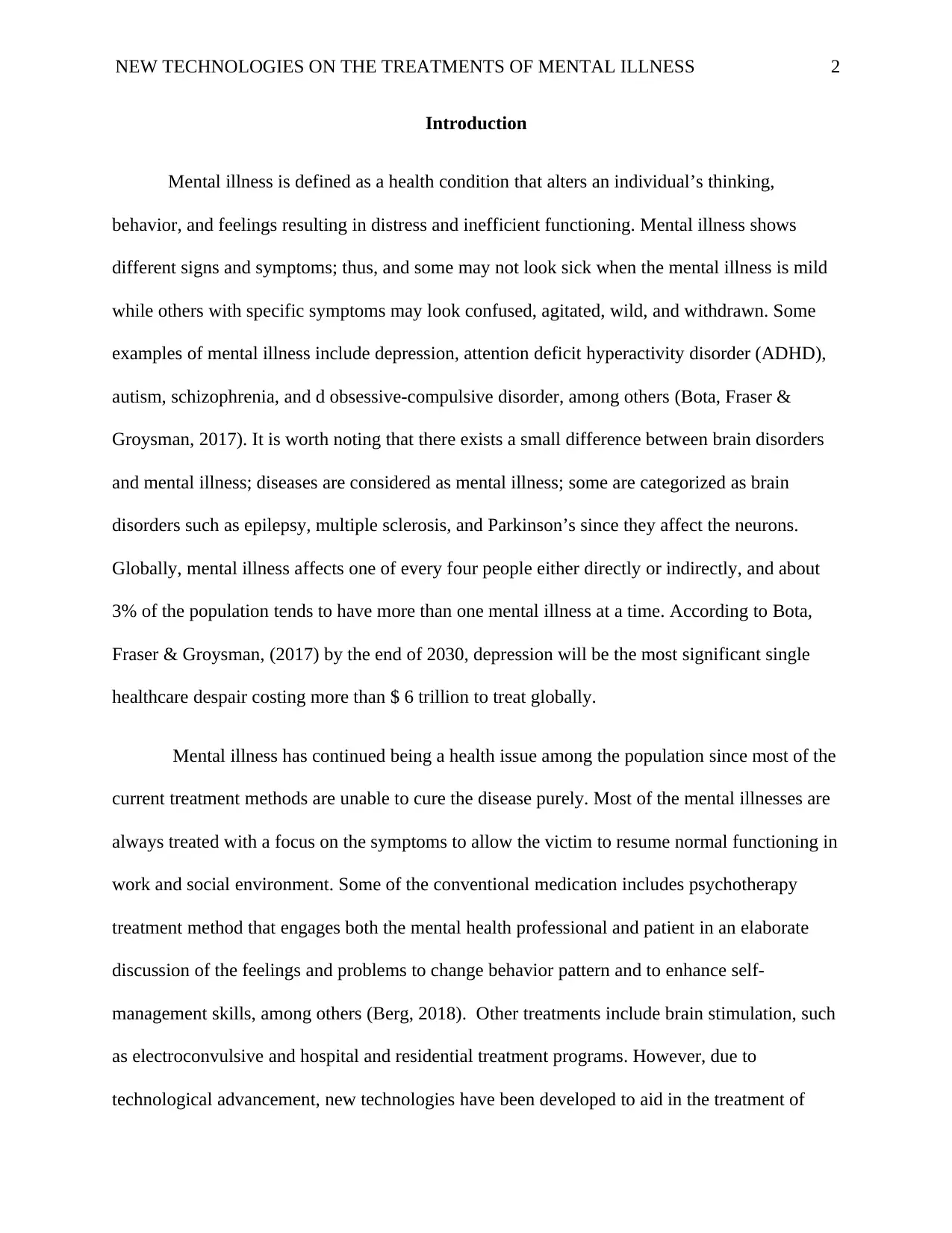
NEW TECHNOLOGIES ON THE TREATMENTS OF MENTAL ILLNESS 2
Introduction
Mental illness is defined as a health condition that alters an individual’s thinking,
behavior, and feelings resulting in distress and inefficient functioning. Mental illness shows
different signs and symptoms; thus, and some may not look sick when the mental illness is mild
while others with specific symptoms may look confused, agitated, wild, and withdrawn. Some
examples of mental illness include depression, attention deficit hyperactivity disorder (ADHD),
autism, schizophrenia, and d obsessive-compulsive disorder, among others (Bota, Fraser &
Groysman, 2017). It is worth noting that there exists a small difference between brain disorders
and mental illness; diseases are considered as mental illness; some are categorized as brain
disorders such as epilepsy, multiple sclerosis, and Parkinson’s since they affect the neurons.
Globally, mental illness affects one of every four people either directly or indirectly, and about
3% of the population tends to have more than one mental illness at a time. According to Bota,
Fraser & Groysman, (2017) by the end of 2030, depression will be the most significant single
healthcare despair costing more than $ 6 trillion to treat globally.
Mental illness has continued being a health issue among the population since most of the
current treatment methods are unable to cure the disease purely. Most of the mental illnesses are
always treated with a focus on the symptoms to allow the victim to resume normal functioning in
work and social environment. Some of the conventional medication includes psychotherapy
treatment method that engages both the mental health professional and patient in an elaborate
discussion of the feelings and problems to change behavior pattern and to enhance self-
management skills, among others (Berg, 2018). Other treatments include brain stimulation, such
as electroconvulsive and hospital and residential treatment programs. However, due to
technological advancement, new technologies have been developed to aid in the treatment of
Introduction
Mental illness is defined as a health condition that alters an individual’s thinking,
behavior, and feelings resulting in distress and inefficient functioning. Mental illness shows
different signs and symptoms; thus, and some may not look sick when the mental illness is mild
while others with specific symptoms may look confused, agitated, wild, and withdrawn. Some
examples of mental illness include depression, attention deficit hyperactivity disorder (ADHD),
autism, schizophrenia, and d obsessive-compulsive disorder, among others (Bota, Fraser &
Groysman, 2017). It is worth noting that there exists a small difference between brain disorders
and mental illness; diseases are considered as mental illness; some are categorized as brain
disorders such as epilepsy, multiple sclerosis, and Parkinson’s since they affect the neurons.
Globally, mental illness affects one of every four people either directly or indirectly, and about
3% of the population tends to have more than one mental illness at a time. According to Bota,
Fraser & Groysman, (2017) by the end of 2030, depression will be the most significant single
healthcare despair costing more than $ 6 trillion to treat globally.
Mental illness has continued being a health issue among the population since most of the
current treatment methods are unable to cure the disease purely. Most of the mental illnesses are
always treated with a focus on the symptoms to allow the victim to resume normal functioning in
work and social environment. Some of the conventional medication includes psychotherapy
treatment method that engages both the mental health professional and patient in an elaborate
discussion of the feelings and problems to change behavior pattern and to enhance self-
management skills, among others (Berg, 2018). Other treatments include brain stimulation, such
as electroconvulsive and hospital and residential treatment programs. However, due to
technological advancement, new technologies have been developed to aid in the treatment of
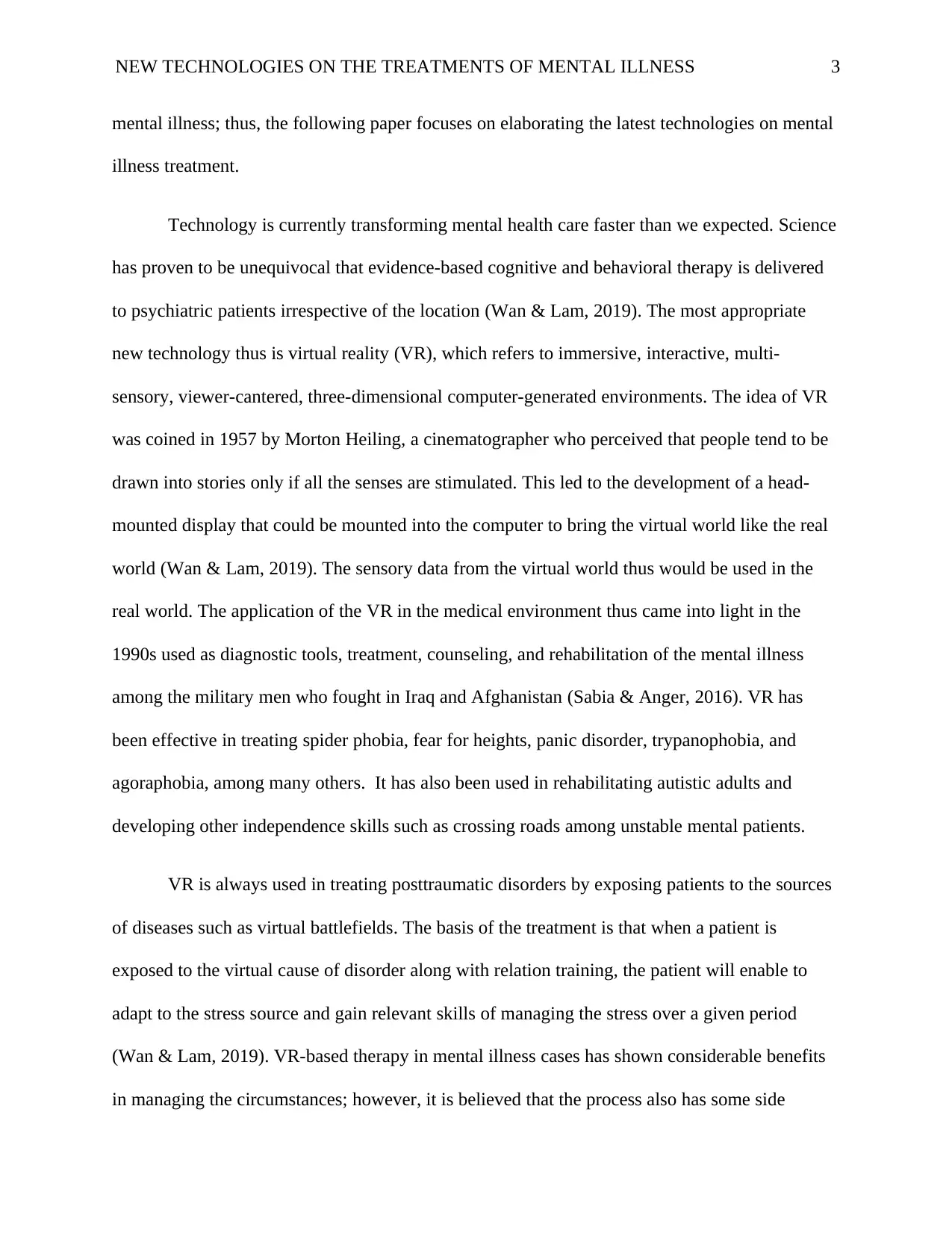
NEW TECHNOLOGIES ON THE TREATMENTS OF MENTAL ILLNESS 3
mental illness; thus, the following paper focuses on elaborating the latest technologies on mental
illness treatment.
Technology is currently transforming mental health care faster than we expected. Science
has proven to be unequivocal that evidence-based cognitive and behavioral therapy is delivered
to psychiatric patients irrespective of the location (Wan & Lam, 2019). The most appropriate
new technology thus is virtual reality (VR), which refers to immersive, interactive, multi-
sensory, viewer-cantered, three-dimensional computer-generated environments. The idea of VR
was coined in 1957 by Morton Heiling, a cinematographer who perceived that people tend to be
drawn into stories only if all the senses are stimulated. This led to the development of a head-
mounted display that could be mounted into the computer to bring the virtual world like the real
world (Wan & Lam, 2019). The sensory data from the virtual world thus would be used in the
real world. The application of the VR in the medical environment thus came into light in the
1990s used as diagnostic tools, treatment, counseling, and rehabilitation of the mental illness
among the military men who fought in Iraq and Afghanistan (Sabia & Anger, 2016). VR has
been effective in treating spider phobia, fear for heights, panic disorder, trypanophobia, and
agoraphobia, among many others. It has also been used in rehabilitating autistic adults and
developing other independence skills such as crossing roads among unstable mental patients.
VR is always used in treating posttraumatic disorders by exposing patients to the sources
of diseases such as virtual battlefields. The basis of the treatment is that when a patient is
exposed to the virtual cause of disorder along with relation training, the patient will enable to
adapt to the stress source and gain relevant skills of managing the stress over a given period
(Wan & Lam, 2019). VR-based therapy in mental illness cases has shown considerable benefits
in managing the circumstances; however, it is believed that the process also has some side
mental illness; thus, the following paper focuses on elaborating the latest technologies on mental
illness treatment.
Technology is currently transforming mental health care faster than we expected. Science
has proven to be unequivocal that evidence-based cognitive and behavioral therapy is delivered
to psychiatric patients irrespective of the location (Wan & Lam, 2019). The most appropriate
new technology thus is virtual reality (VR), which refers to immersive, interactive, multi-
sensory, viewer-cantered, three-dimensional computer-generated environments. The idea of VR
was coined in 1957 by Morton Heiling, a cinematographer who perceived that people tend to be
drawn into stories only if all the senses are stimulated. This led to the development of a head-
mounted display that could be mounted into the computer to bring the virtual world like the real
world (Wan & Lam, 2019). The sensory data from the virtual world thus would be used in the
real world. The application of the VR in the medical environment thus came into light in the
1990s used as diagnostic tools, treatment, counseling, and rehabilitation of the mental illness
among the military men who fought in Iraq and Afghanistan (Sabia & Anger, 2016). VR has
been effective in treating spider phobia, fear for heights, panic disorder, trypanophobia, and
agoraphobia, among many others. It has also been used in rehabilitating autistic adults and
developing other independence skills such as crossing roads among unstable mental patients.
VR is always used in treating posttraumatic disorders by exposing patients to the sources
of diseases such as virtual battlefields. The basis of the treatment is that when a patient is
exposed to the virtual cause of disorder along with relation training, the patient will enable to
adapt to the stress source and gain relevant skills of managing the stress over a given period
(Wan & Lam, 2019). VR-based therapy in mental illness cases has shown considerable benefits
in managing the circumstances; however, it is believed that the process also has some side
⊘ This is a preview!⊘
Do you want full access?
Subscribe today to unlock all pages.

Trusted by 1+ million students worldwide
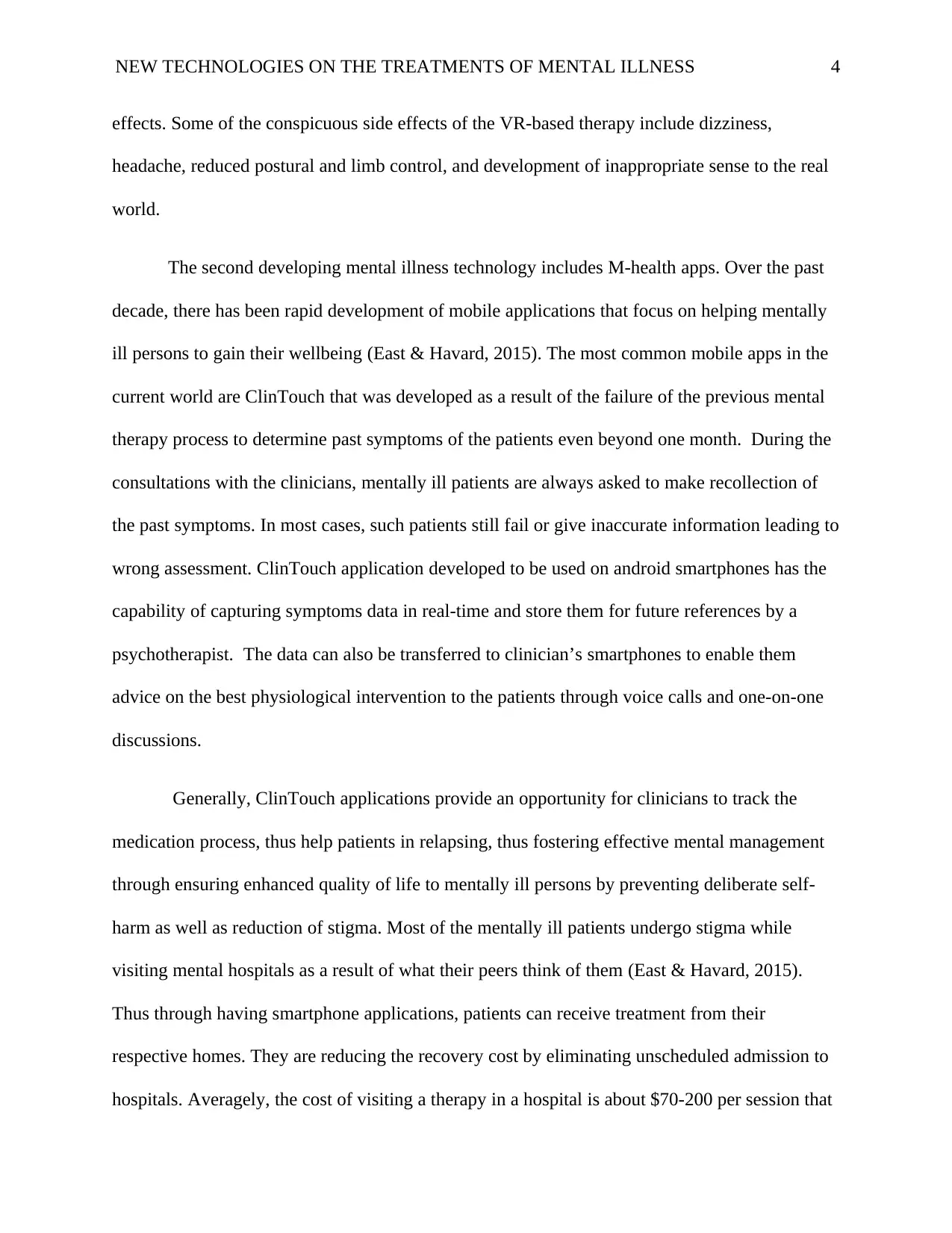
NEW TECHNOLOGIES ON THE TREATMENTS OF MENTAL ILLNESS 4
effects. Some of the conspicuous side effects of the VR-based therapy include dizziness,
headache, reduced postural and limb control, and development of inappropriate sense to the real
world.
The second developing mental illness technology includes M-health apps. Over the past
decade, there has been rapid development of mobile applications that focus on helping mentally
ill persons to gain their wellbeing (East & Havard, 2015). The most common mobile apps in the
current world are ClinTouch that was developed as a result of the failure of the previous mental
therapy process to determine past symptoms of the patients even beyond one month. During the
consultations with the clinicians, mentally ill patients are always asked to make recollection of
the past symptoms. In most cases, such patients still fail or give inaccurate information leading to
wrong assessment. ClinTouch application developed to be used on android smartphones has the
capability of capturing symptoms data in real-time and store them for future references by a
psychotherapist. The data can also be transferred to clinician’s smartphones to enable them
advice on the best physiological intervention to the patients through voice calls and one-on-one
discussions.
Generally, ClinTouch applications provide an opportunity for clinicians to track the
medication process, thus help patients in relapsing, thus fostering effective mental management
through ensuring enhanced quality of life to mentally ill persons by preventing deliberate self-
harm as well as reduction of stigma. Most of the mentally ill patients undergo stigma while
visiting mental hospitals as a result of what their peers think of them (East & Havard, 2015).
Thus through having smartphone applications, patients can receive treatment from their
respective homes. They are reducing the recovery cost by eliminating unscheduled admission to
hospitals. Averagely, the cost of visiting a therapy in a hospital is about $70-200 per session that
effects. Some of the conspicuous side effects of the VR-based therapy include dizziness,
headache, reduced postural and limb control, and development of inappropriate sense to the real
world.
The second developing mental illness technology includes M-health apps. Over the past
decade, there has been rapid development of mobile applications that focus on helping mentally
ill persons to gain their wellbeing (East & Havard, 2015). The most common mobile apps in the
current world are ClinTouch that was developed as a result of the failure of the previous mental
therapy process to determine past symptoms of the patients even beyond one month. During the
consultations with the clinicians, mentally ill patients are always asked to make recollection of
the past symptoms. In most cases, such patients still fail or give inaccurate information leading to
wrong assessment. ClinTouch application developed to be used on android smartphones has the
capability of capturing symptoms data in real-time and store them for future references by a
psychotherapist. The data can also be transferred to clinician’s smartphones to enable them
advice on the best physiological intervention to the patients through voice calls and one-on-one
discussions.
Generally, ClinTouch applications provide an opportunity for clinicians to track the
medication process, thus help patients in relapsing, thus fostering effective mental management
through ensuring enhanced quality of life to mentally ill persons by preventing deliberate self-
harm as well as reduction of stigma. Most of the mentally ill patients undergo stigma while
visiting mental hospitals as a result of what their peers think of them (East & Havard, 2015).
Thus through having smartphone applications, patients can receive treatment from their
respective homes. They are reducing the recovery cost by eliminating unscheduled admission to
hospitals. Averagely, the cost of visiting a therapy in a hospital is about $70-200 per session that
Paraphrase This Document
Need a fresh take? Get an instant paraphrase of this document with our AI Paraphraser
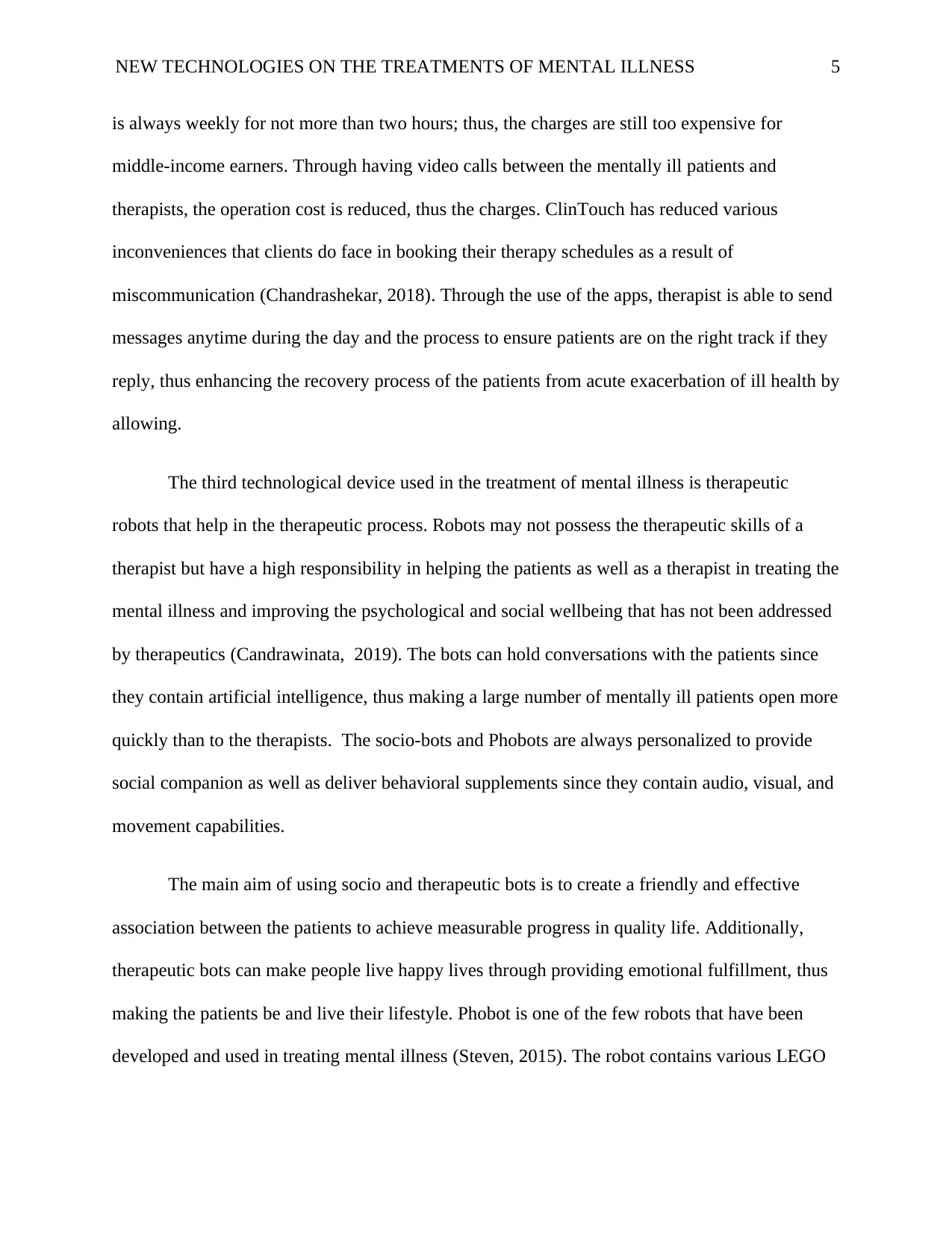
NEW TECHNOLOGIES ON THE TREATMENTS OF MENTAL ILLNESS 5
is always weekly for not more than two hours; thus, the charges are still too expensive for
middle-income earners. Through having video calls between the mentally ill patients and
therapists, the operation cost is reduced, thus the charges. ClinTouch has reduced various
inconveniences that clients do face in booking their therapy schedules as a result of
miscommunication (Chandrashekar, 2018). Through the use of the apps, therapist is able to send
messages anytime during the day and the process to ensure patients are on the right track if they
reply, thus enhancing the recovery process of the patients from acute exacerbation of ill health by
allowing.
The third technological device used in the treatment of mental illness is therapeutic
robots that help in the therapeutic process. Robots may not possess the therapeutic skills of a
therapist but have a high responsibility in helping the patients as well as a therapist in treating the
mental illness and improving the psychological and social wellbeing that has not been addressed
by therapeutics (Candrawinata, 2019). The bots can hold conversations with the patients since
they contain artificial intelligence, thus making a large number of mentally ill patients open more
quickly than to the therapists. The socio-bots and Phobots are always personalized to provide
social companion as well as deliver behavioral supplements since they contain audio, visual, and
movement capabilities.
The main aim of using socio and therapeutic bots is to create a friendly and effective
association between the patients to achieve measurable progress in quality life. Additionally,
therapeutic bots can make people live happy lives through providing emotional fulfillment, thus
making the patients be and live their lifestyle. Phobot is one of the few robots that have been
developed and used in treating mental illness (Steven, 2015). The robot contains various LEGO
is always weekly for not more than two hours; thus, the charges are still too expensive for
middle-income earners. Through having video calls between the mentally ill patients and
therapists, the operation cost is reduced, thus the charges. ClinTouch has reduced various
inconveniences that clients do face in booking their therapy schedules as a result of
miscommunication (Chandrashekar, 2018). Through the use of the apps, therapist is able to send
messages anytime during the day and the process to ensure patients are on the right track if they
reply, thus enhancing the recovery process of the patients from acute exacerbation of ill health by
allowing.
The third technological device used in the treatment of mental illness is therapeutic
robots that help in the therapeutic process. Robots may not possess the therapeutic skills of a
therapist but have a high responsibility in helping the patients as well as a therapist in treating the
mental illness and improving the psychological and social wellbeing that has not been addressed
by therapeutics (Candrawinata, 2019). The bots can hold conversations with the patients since
they contain artificial intelligence, thus making a large number of mentally ill patients open more
quickly than to the therapists. The socio-bots and Phobots are always personalized to provide
social companion as well as deliver behavioral supplements since they contain audio, visual, and
movement capabilities.
The main aim of using socio and therapeutic bots is to create a friendly and effective
association between the patients to achieve measurable progress in quality life. Additionally,
therapeutic bots can make people live happy lives through providing emotional fulfillment, thus
making the patients be and live their lifestyle. Phobot is one of the few robots that have been
developed and used in treating mental illness (Steven, 2015). The robot contains various LEGO
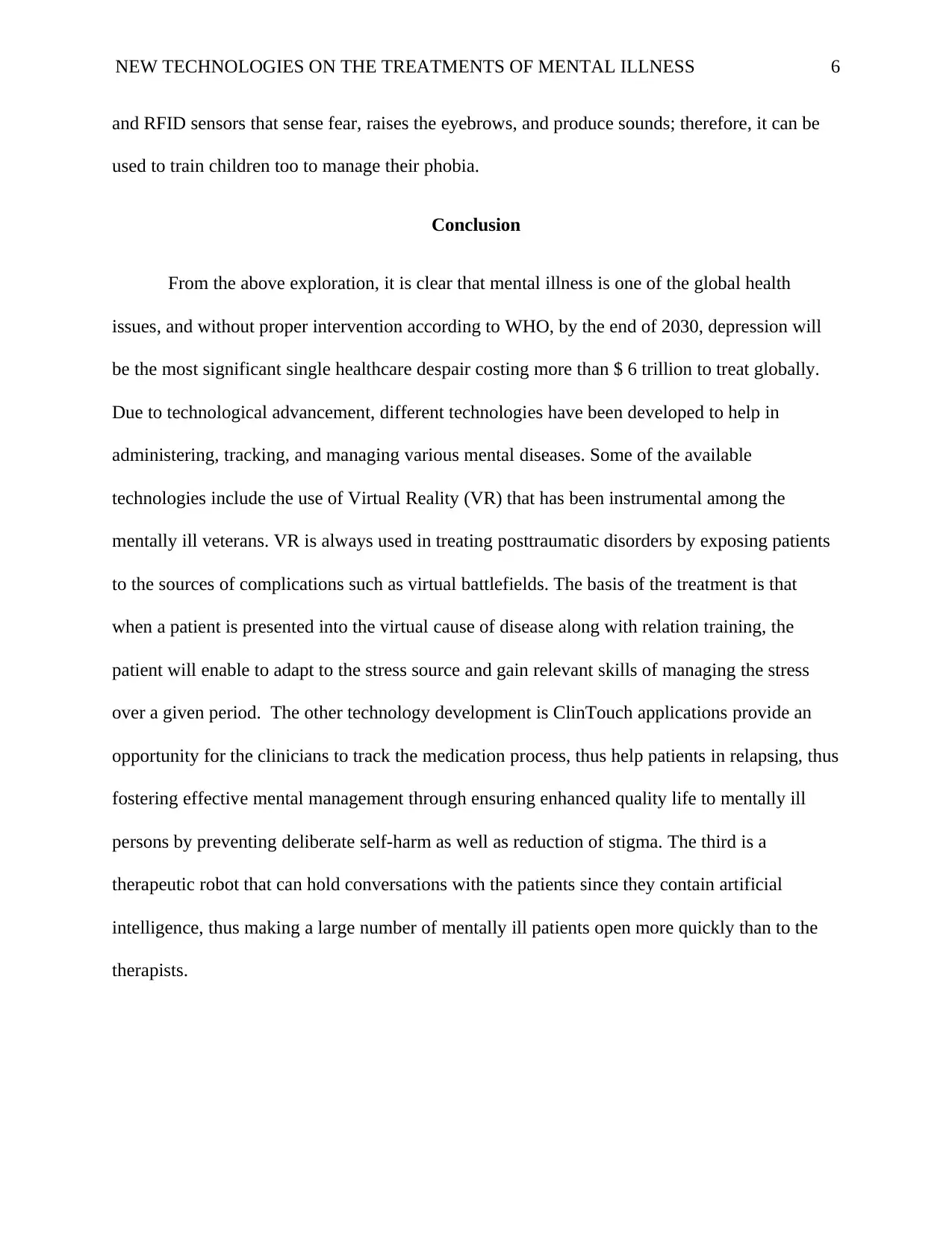
NEW TECHNOLOGIES ON THE TREATMENTS OF MENTAL ILLNESS 6
and RFID sensors that sense fear, raises the eyebrows, and produce sounds; therefore, it can be
used to train children too to manage their phobia.
Conclusion
From the above exploration, it is clear that mental illness is one of the global health
issues, and without proper intervention according to WHO, by the end of 2030, depression will
be the most significant single healthcare despair costing more than $ 6 trillion to treat globally.
Due to technological advancement, different technologies have been developed to help in
administering, tracking, and managing various mental diseases. Some of the available
technologies include the use of Virtual Reality (VR) that has been instrumental among the
mentally ill veterans. VR is always used in treating posttraumatic disorders by exposing patients
to the sources of complications such as virtual battlefields. The basis of the treatment is that
when a patient is presented into the virtual cause of disease along with relation training, the
patient will enable to adapt to the stress source and gain relevant skills of managing the stress
over a given period. The other technology development is ClinTouch applications provide an
opportunity for the clinicians to track the medication process, thus help patients in relapsing, thus
fostering effective mental management through ensuring enhanced quality life to mentally ill
persons by preventing deliberate self-harm as well as reduction of stigma. The third is a
therapeutic robot that can hold conversations with the patients since they contain artificial
intelligence, thus making a large number of mentally ill patients open more quickly than to the
therapists.
and RFID sensors that sense fear, raises the eyebrows, and produce sounds; therefore, it can be
used to train children too to manage their phobia.
Conclusion
From the above exploration, it is clear that mental illness is one of the global health
issues, and without proper intervention according to WHO, by the end of 2030, depression will
be the most significant single healthcare despair costing more than $ 6 trillion to treat globally.
Due to technological advancement, different technologies have been developed to help in
administering, tracking, and managing various mental diseases. Some of the available
technologies include the use of Virtual Reality (VR) that has been instrumental among the
mentally ill veterans. VR is always used in treating posttraumatic disorders by exposing patients
to the sources of complications such as virtual battlefields. The basis of the treatment is that
when a patient is presented into the virtual cause of disease along with relation training, the
patient will enable to adapt to the stress source and gain relevant skills of managing the stress
over a given period. The other technology development is ClinTouch applications provide an
opportunity for the clinicians to track the medication process, thus help patients in relapsing, thus
fostering effective mental management through ensuring enhanced quality life to mentally ill
persons by preventing deliberate self-harm as well as reduction of stigma. The third is a
therapeutic robot that can hold conversations with the patients since they contain artificial
intelligence, thus making a large number of mentally ill patients open more quickly than to the
therapists.
⊘ This is a preview!⊘
Do you want full access?
Subscribe today to unlock all pages.

Trusted by 1+ million students worldwide
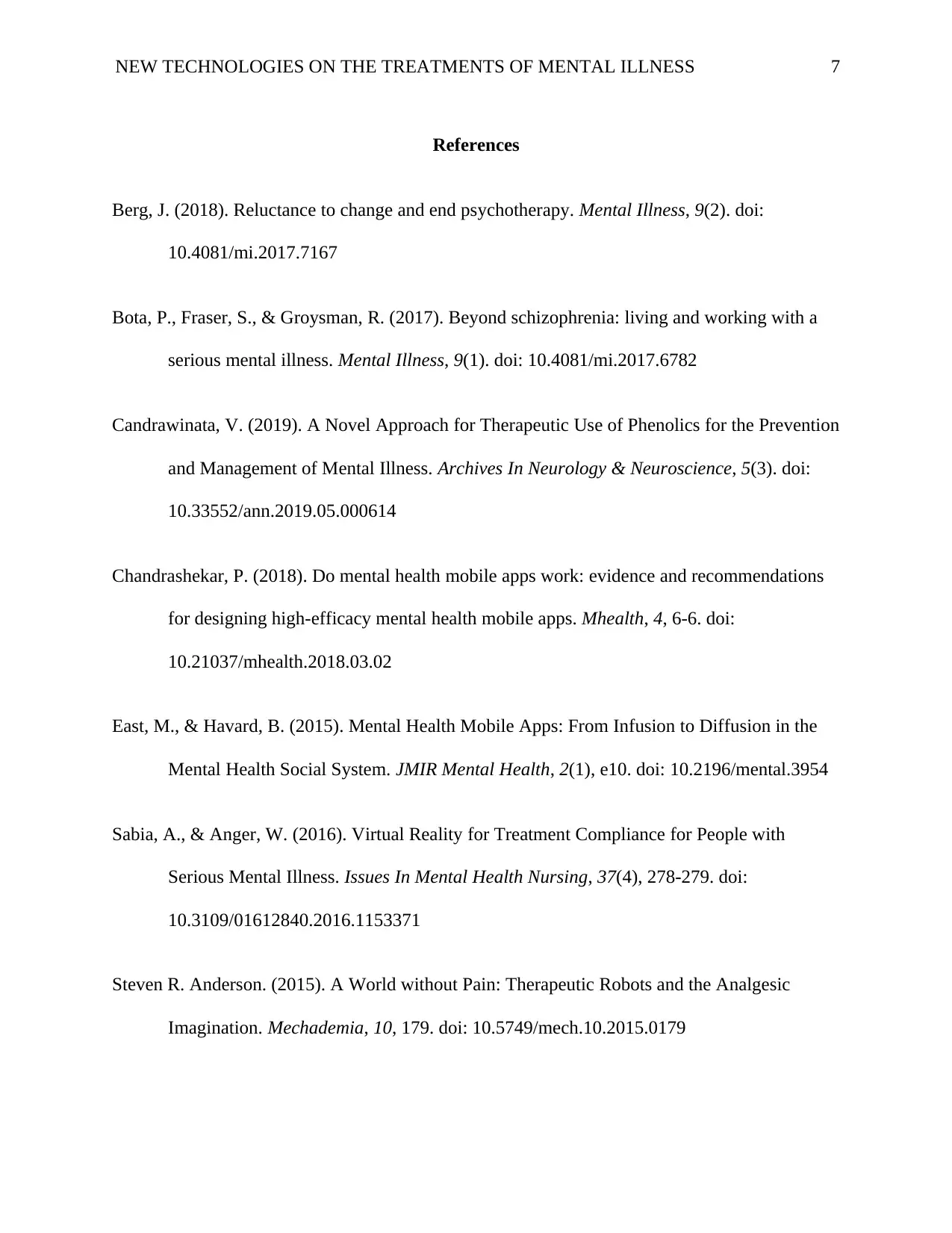
NEW TECHNOLOGIES ON THE TREATMENTS OF MENTAL ILLNESS 7
References
Berg, J. (2018). Reluctance to change and end psychotherapy. Mental Illness, 9(2). doi:
10.4081/mi.2017.7167
Bota, P., Fraser, S., & Groysman, R. (2017). Beyond schizophrenia: living and working with a
serious mental illness. Mental Illness, 9(1). doi: 10.4081/mi.2017.6782
Candrawinata, V. (2019). A Novel Approach for Therapeutic Use of Phenolics for the Prevention
and Management of Mental Illness. Archives In Neurology & Neuroscience, 5(3). doi:
10.33552/ann.2019.05.000614
Chandrashekar, P. (2018). Do mental health mobile apps work: evidence and recommendations
for designing high-efficacy mental health mobile apps. Mhealth, 4, 6-6. doi:
10.21037/mhealth.2018.03.02
East, M., & Havard, B. (2015). Mental Health Mobile Apps: From Infusion to Diffusion in the
Mental Health Social System. JMIR Mental Health, 2(1), e10. doi: 10.2196/mental.3954
Sabia, A., & Anger, W. (2016). Virtual Reality for Treatment Compliance for People with
Serious Mental Illness. Issues In Mental Health Nursing, 37(4), 278-279. doi:
10.3109/01612840.2016.1153371
Steven R. Anderson. (2015). A World without Pain: Therapeutic Robots and the Analgesic
Imagination. Mechademia, 10, 179. doi: 10.5749/mech.10.2015.0179
References
Berg, J. (2018). Reluctance to change and end psychotherapy. Mental Illness, 9(2). doi:
10.4081/mi.2017.7167
Bota, P., Fraser, S., & Groysman, R. (2017). Beyond schizophrenia: living and working with a
serious mental illness. Mental Illness, 9(1). doi: 10.4081/mi.2017.6782
Candrawinata, V. (2019). A Novel Approach for Therapeutic Use of Phenolics for the Prevention
and Management of Mental Illness. Archives In Neurology & Neuroscience, 5(3). doi:
10.33552/ann.2019.05.000614
Chandrashekar, P. (2018). Do mental health mobile apps work: evidence and recommendations
for designing high-efficacy mental health mobile apps. Mhealth, 4, 6-6. doi:
10.21037/mhealth.2018.03.02
East, M., & Havard, B. (2015). Mental Health Mobile Apps: From Infusion to Diffusion in the
Mental Health Social System. JMIR Mental Health, 2(1), e10. doi: 10.2196/mental.3954
Sabia, A., & Anger, W. (2016). Virtual Reality for Treatment Compliance for People with
Serious Mental Illness. Issues In Mental Health Nursing, 37(4), 278-279. doi:
10.3109/01612840.2016.1153371
Steven R. Anderson. (2015). A World without Pain: Therapeutic Robots and the Analgesic
Imagination. Mechademia, 10, 179. doi: 10.5749/mech.10.2015.0179
Paraphrase This Document
Need a fresh take? Get an instant paraphrase of this document with our AI Paraphraser
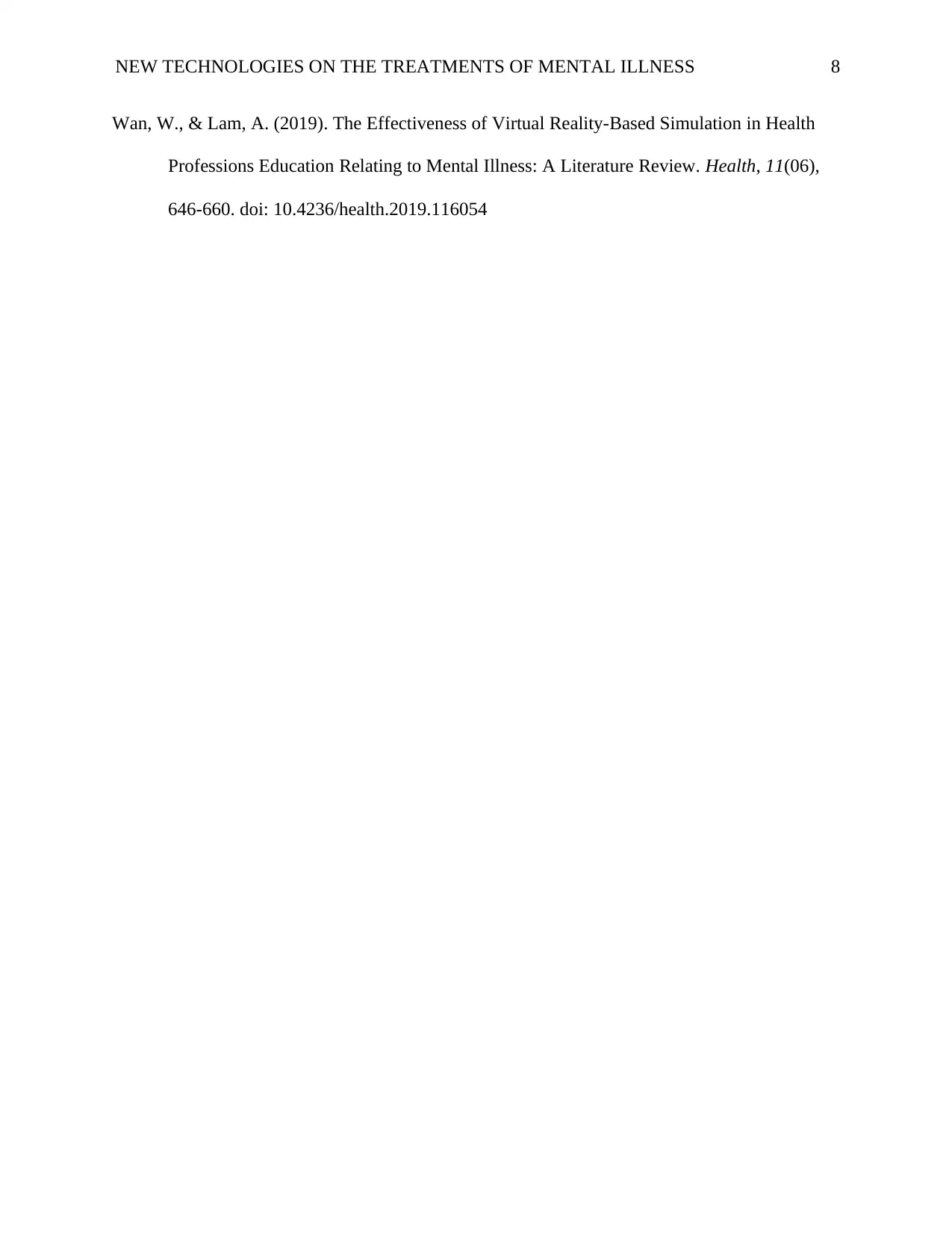
NEW TECHNOLOGIES ON THE TREATMENTS OF MENTAL ILLNESS 8
Wan, W., & Lam, A. (2019). The Effectiveness of Virtual Reality-Based Simulation in Health
Professions Education Relating to Mental Illness: A Literature Review. Health, 11(06),
646-660. doi: 10.4236/health.2019.116054
Wan, W., & Lam, A. (2019). The Effectiveness of Virtual Reality-Based Simulation in Health
Professions Education Relating to Mental Illness: A Literature Review. Health, 11(06),
646-660. doi: 10.4236/health.2019.116054
1 out of 8
Related Documents
Your All-in-One AI-Powered Toolkit for Academic Success.
+13062052269
info@desklib.com
Available 24*7 on WhatsApp / Email
![[object Object]](/_next/static/media/star-bottom.7253800d.svg)
Unlock your academic potential
Copyright © 2020–2025 A2Z Services. All Rights Reserved. Developed and managed by ZUCOL.





